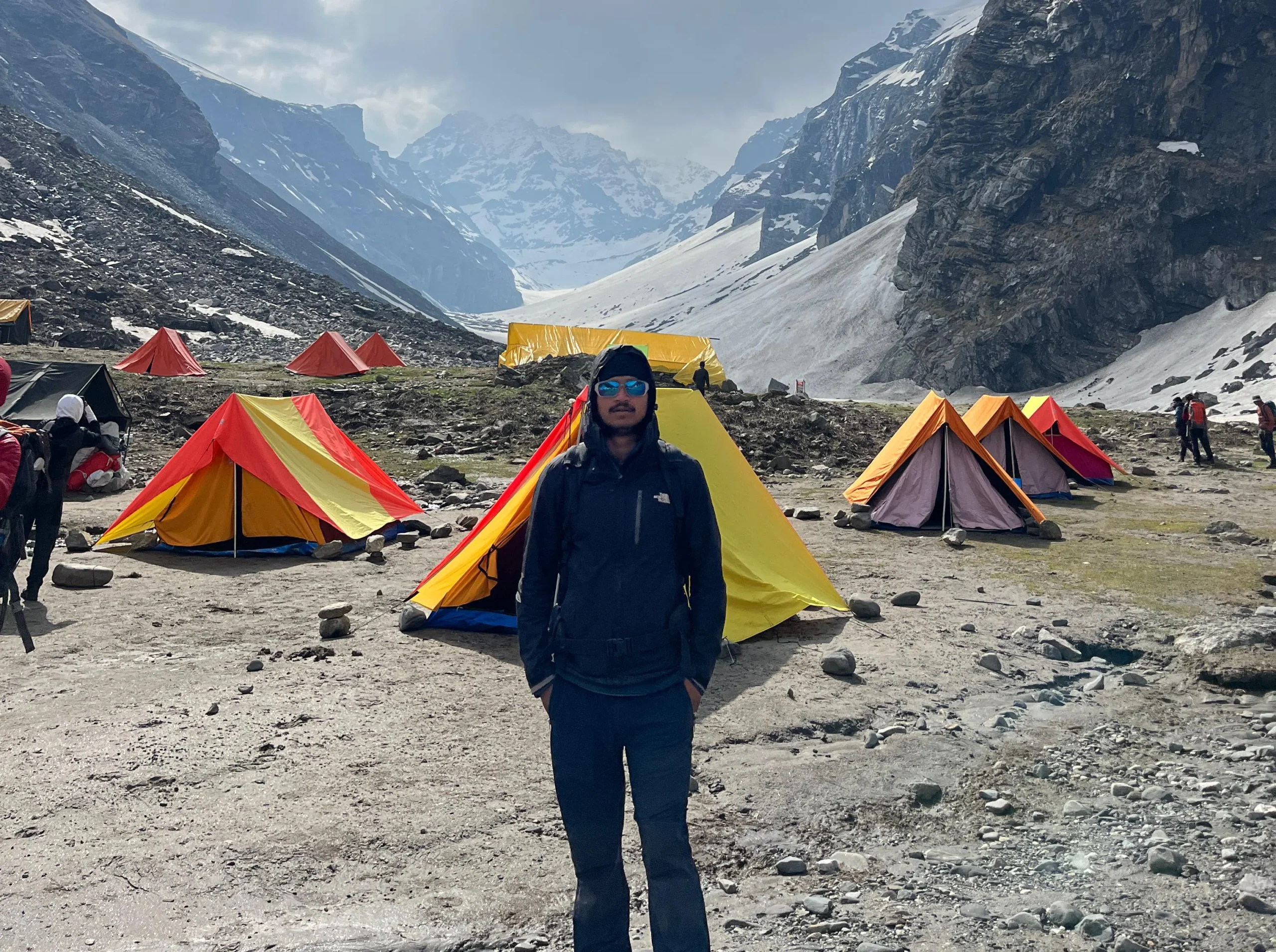Chandratal Sarovar
Published on June 30, 2025
Hidden deep in the majestic Himalayan ranges of Himachal Pradesh lies a surreal, crescent-shaped lake that has captured the imagination of trekkers, photographers, and dreamers — Chandratal Lake, or “The Moon Lake.” Situated at an altitude of 4,300 meters (14,100 ft) in the Spiti Valley region of the Lahaul and Spiti district, Chandratal is a shimmering turquoise gem set against a stark, high-altitude desert backdrop.
This high-altitude lake is often the final highlight of the popular Hampta Pass Trek, offering a complete contrast from the greenery of Kullu to the barren beauty of Spiti. Let’s explore everything about Chandratal Lake — from its origin and spiritual significance to camping, accessibility, and photography.
Where is Chandratal Lake?
Chandratal is located near the Kunzum Pass, in the Lahaul region of Himachal Pradesh. It's approximately 14 km from the nearest motorable point near Batal, and around 125 km from Manali.
The lake is shaped like a crescent moon, hence the name “Chandra-Tal” – Chandra meaning moon and Tal meaning lake in Hindi.

Mythology and Legends of Chandratal
The lake is not just a visual marvel, but a place steeped in mythological lore.
According to local beliefs:
-
Chandratal is the meeting point of Lord Indra and Yudhishthira, the eldest Pandava from the Mahabharata, where Indra’s chariot came to take him to heaven.
-
It is considered a sacred lake, and local shepherds and villagers offer prayers and walk barefoot around it as a mark of reverence.
Even today, you’ll find many visitors making a parikrama (circumambulation) of the lake, which takes around 45 minutes.
How to Reach Chandratal Lake?
There are two main ways to reach Chandratal:
1. Via Hampta Pass Trek (Most Popular Among Trekkers)
-
Starts from Jobra (near Manali) and ends at Chandratal via Hampta Pass, Shea Goru, and Chatru.
-
Usually a 5-6 day trek, with Chandratal being the final stop.
-
Requires good fitness, camping experience, and a trekking guide.
2. By Road via Manali – Atal Tunnel – Batal
-
Accessible by SUVs or bikes from June to mid-October.
-
Manali → Gramphu → Chhatru → Batal → Chandratal
-
From the parking point near Kuna Bhatti, you trek around 1.5 km to reach the lake.
Note: The roads are rugged, narrow, and often get blocked due to landslides or snow. Always check weather and road status before visiting.
Beauty of the Lake – Nature’s Masterpiece
Chandratal Lake is a high-altitude glacial lake, fed by underground springs and melting snow from nearby peaks like Chandra Bhaga and Mulkila.
Key highlights:
-
Water changes color during the day — blue in the morning, greenish by afternoon, and orange-pink during sunset.
-
Set in a wide alpine meadow surrounded by towering, barren mountains.
-
In summer, the surrounding meadows bloom with wildflowers, adding colour to the desert-like landscape.
-
No trees, no noise, just endless sky and silence — making it a surreal, almost mystical experience.
Camping Near Chandratal
Camping near Chandratal is one of the most unforgettable parts of the journey. Since camping is not allowed right next to the lake (to preserve its ecology), campsites are set up around 2–3 km before the lake, near Samudra Tapu or Kuna Bhatti.
Camping Experience:
-
Tents on a flat grassland under a vast sky
-
Views of the Milky Way and shooting stars
-
Bone-chilling cold even in summer nights
-
Hot meals are served in shared dining tents
-
Ideal for photographers, stargazers, and adventure lovers
Make sure to carry warm clothes, thermal wear, and a good sleeping bag.

Weather and Best Time to Visit
The best time to visit Chandratal is from mid-June to mid-October. Outside this window, the region remains snow-covered and inaccessible due to heavy snowfall and road closures.
Typical weather conditions:
-
Day: 10°C – 15°C
-
Night: Drops to 5°C to 0°C (even in July)
-
Wind: Strong and sudden gusts in the afternoon/evening
-
Rainfall: Minimal, as this lies in a rain-shadow zone
Always check road updates during monsoon, as landslides around Batal and Gramphu are common.
Photography Paradise
Chandratal is a dream for landscape photographers. Its mirror-like surface reflects the surrounding peaks, and the absence of pollution makes the skies exceptionally clear.
What to shoot:
-
Golden hour lake reflections
-
Milky Way and night-sky astrophotography
-
Time-lapse of shifting colours of the lake
-
Macro shots of wildflowers in nearby meadows
-
Long exposure images of star trails and mountain silhouettes
Pro tip: Carry extra batteries and a tripod — cold drains power quickly.
Things to Remember & Tips for Visitors
-
No boating or swimming is allowed in the lake.
-
Do not litter — carry all trash back with you.
-
Use eco-friendly toiletries and wet wipes only.
-
If you feel dizziness, nausea, or fatigue, descend to a lower altitude — AMS (Acute Mountain Sickness) can hit at Chandratal.
-
Mobile network is unavailable – inform family before you go offline.
-
Carry power banks, torches, and extra camera gear.
Nearby Places to Explore
If you’re visiting by vehicle or extending your trek, you can also explore:
-
Kunzum Pass (4,551 m): Gateway to Spiti Valley
-
Baralacha La: Another high-altitude pass near Jispa
-
Chatru & Batal: Remote villages/campsites on the way
-
Kaza: Cultural capital of Spiti (further east)
Chandratal – The Himalayan Dreamscape
Chandratal Lake is not just a destination; it’s a spiritual and visual experience. Whether you trek your way across Hampta Pass or take a bumpy but exciting road journey, the moment you see that moon-shaped lake shimmering under the clear Himalayan sky — you’ll forget the fatigue, the altitude, the road.
It’s the kind of place that stays with you — in your photographs, in your journal, and in your heart.
.jpg)